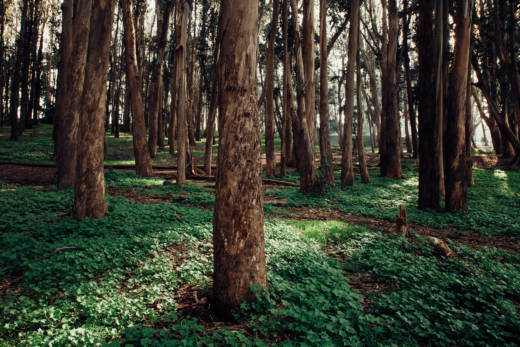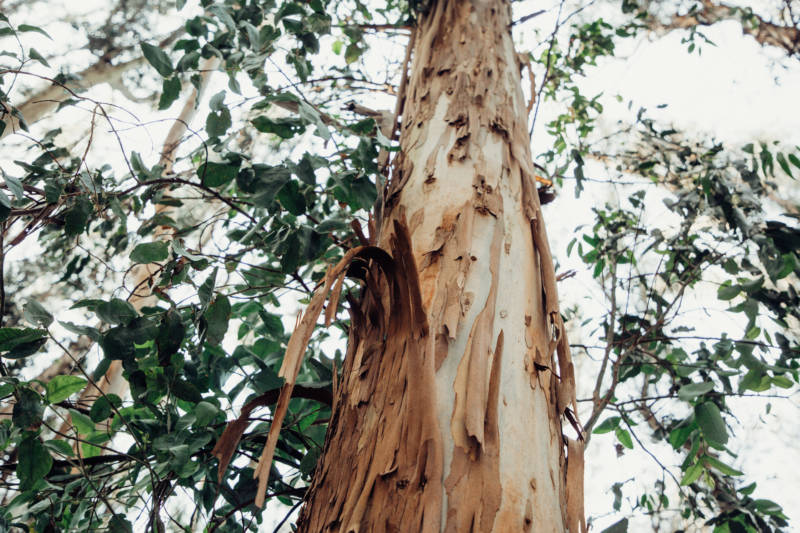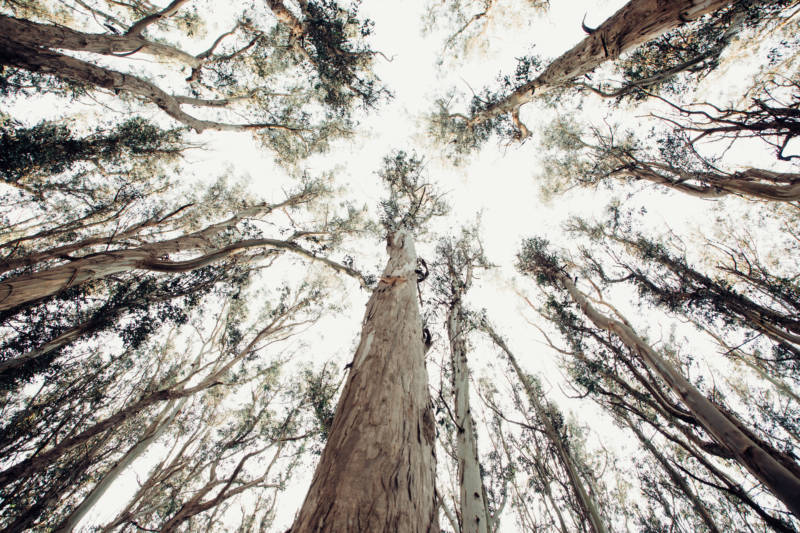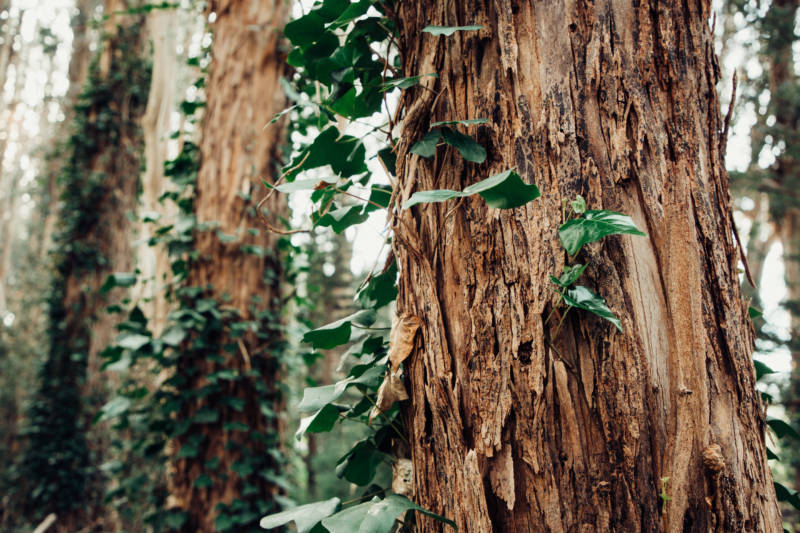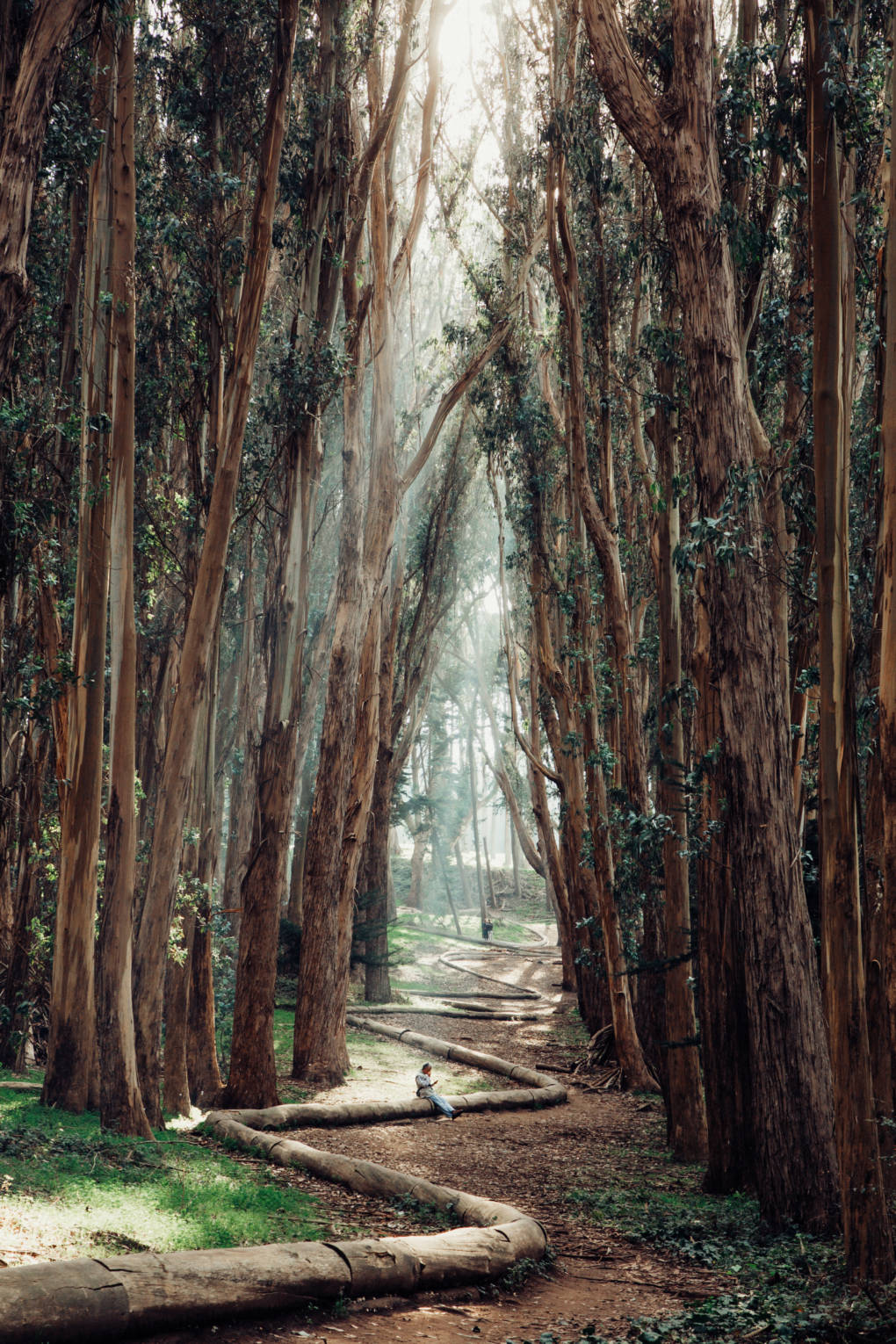Episode Transcript
Olivia Allen-Price: Do you see any koala bears?
Daniel Potter: I wish.
[sound of bark crunching underfoot]
Daniel Potter: Should we tell people where we are?
Olivia Allen-Price: Yeah, so we are at the Mount Sutro Open Space Reserve. Which has gotta be pretty close to the geographic center of San Francisco, would you imagine, right?
Daniel Potter: I think that’s fair. And we are surrounded by a ton of what look to be ancient eucalyptus trees.
Olivia Allen-Price: If you’re not familiar with eucalyptus trees, they’re very tall. How tall would you say those are?
Daniel Potter: We’ve seen some today over a hundred feet, for sure.
Olivia Allen-Price: Definitely. And they have this weird bark, where the underpart of the tree is really smooth but their bark on the outside flakes off.
Daniel Potter: It’s deciduous, but it leaves this tan, almost naked-looking trunk behind.
Olivia Allen-Price: And these would not be good climbing trees.
Daniel Potter: Yeah, most of the branches, like, what’s the lowest branch on that one? It’s like 30 feet up, how are you gonna climb that?
Olivia Allen-Price: One thing I think a lot of people remark about eucalyptus trees in the smell.
(inhale, exhale)
Daniel Potter: Some people hate it. But a couple people I talked to for this story—they say these trees just smell like California.
Olivia Allen-Price: Which is pretty weird for a tree from Australia!
Theme music
Olivia Allen-Price: I’m Olivia Allen-Price, and this is Bay Curious, where we answer your questions about the Bay Area. On this episode, science writer Daniel Potter and I take a closer look at Eucalyptus Trees.
Daniel Potter: They have lovers—and haters.
Olivia Allen-Price: And there are giant stands of them throughout our region. This story first ran in 2018, but your questions about eucalyptus trees have kept on coming! So we thought it was time to freshen up this episode with some new information. We’ll get to it right after this.
Sponsor Message
Olivia Allen-Price: Alright! Let’s get to this week’s question, shall we? Or should I say QUESTIONS because we heard from two different listeners on this one…
Christian Wagner: How did all of this eucalyptus get to the Bay Area?
Olivia Allen-Price: That’s Christian Wagner. He’s noticed lots of eucalyptus trees as he’s out and about because he likes hiking.
Daniel Potter: –as does Julie Bergen.
Julie Bergen: And I know that they’re invasive, so what do we do about that? Are they worth keeping around? Or do we need to get rid of them and replace them with something else?
Olivia Allen-Price: Christian and Julie both wonder about eucalyptus’ past—and its future here. Some people argue the trees are bad for native plant life—and a fire hazard—and need to go. So. Science writer Daniel Potter!
Daniel Potter: Howdy.
Olivia Allen-Price: Where do we begin unraveling this one?
Daniel Potter: In a forest.
Albany Hill outdoor ambi
Daniel Potter: Let’s start with one on Albany Hill in the East Bay. You can see it from I-80, near the racetrack. That’s where I talked to this guy…
Jared Farmer: My name is Jared Farmer, I’m a professor of history at Stony Brook University, and the author of Trees In Paradise: A California History.
Daniel Potter: That book includes a solid hundred pages on eucalyptus trees in California, so I asked Farmer how they got here:
Jared Farmer: They came here as envelopes of seeds on boats in the 1850s.
Daniel Potter: He says the Gold Rush drew people from all over—including from Australia.
Sea shanty music …“In South Australia I was born, heed away all the way”
Daniel Potter: And they were coming to a place where wood was in short supply.
Jared Farmer: What we think of today as like say native California, Indigenous California, or pre-contact California was far more woody than wooded. Actually it was far more land that was chaparral and savanna and wetland and marshland than timberland…
Daniel Potter: People settling here wanted to plant trees.
Olivia Allen-Price: If you’re used to trees, the California landscape might feel… incomplete without them.
Daniel Potter: And then there were the practical concerns, since Californians were quickly downing what trees were here.
Jared Farmer: This was course just the era of wood power—wood was used for almost everything. For energy of course but also for building every city, for moving things around, all the things today we use concrete and plastic and steel.
Daniel Potter: So by the 1850s you could buy young eucalyptus in nurseries in San Francisco. It was grown here from seed, which meant it didn’t bring along any of the usual bugs or pathogens it faces back home. The lack of pests made it easy for these trees to grow really tall, really fast.
(Berkeley outdoor ambi)
Joe McBride: I would say in an average rainfall year here in California, these trees probably put on four to six feet in height.
Daniel Potter: This is Joe McBride, professor emeritus of landscape architecture and environmental planning at UC Berkeley. I met him in a towering stand of ancient eucalyptus on campus.
Joe McBride: These trees are now over 200 feet tall, and the largest ones are approaching six feet in diameter.
Daniel Potter: Near the present-day Life Sciences building there used to be a cinder running track—picture fine ashen gravel. A hundred and forty years ago … at a fabled track meet with Stanford … supposedly the wind was so bad it blew cinder in everyone’s faces and the Stanford coach took his team home—track meet over.
Joe McBride: As a result of that, the campus planted this grove of eucalyptus trees as a windbreak, to prevent the wind from blowing the cinders into other athletes eyes in the future. This is the largest, densest stand of blue gum eucalyptus in the world.
Olivia Allen-Price: Tell us what that is— blue gum eucalyptus…
Daniel Potter: So, the genus eucalyptus includes hundreds of species—some more like shrubs than giant trees. A lot were tried out here, but the main one today is Tasmanian blue gum, eucalyptus globulus. Side note: apparently even botanists can’t always tell what species they’re looking at without climbing way up to check out the fruit…
Olivia Allen-Price: So for a time these trees were planted on purpose – but many people came to hate them. What changed?
Jared Farmer: If you go back to California farm journals of the 1870s, 80s, 90s, there’s report after report of disappointment, like these trees are no good.
Daniel Potter: That’s Jared Farmer, the historian again. It turns out while our blue gum gets tall real fast, it’s not ideal for woodworking—it splits and cracks and doesn’t hold up if you’re making railroad ties. It also sucks up a lot of water, which is handy if you’re trying to drain swampland, but less handy if your well is nearby. People were kinda over it. Until!
Joe McBride: At the turn of the 20th century, we were faced with a crisis in terms of hardwood forest that had been cut over in the eastern United States.
Daniel Potter: In 1907, the U.S. Forest Service predicted a looming hardwood famine. People thought there was only about a 15-year supply before we ran out of usable forest. That gave eucalyptus boosters an idea: plant now, and fast-growing blue gums could be big enough to harvest once the famine hits.
Joe McBride: Here in the Bay Area, for $100 you could buy an acre of land… planting those trees on 6 by 6 spacing, about 1,200 trees per acre. So they sold lots of these on a speculative basis.
Daniel Potter: This became a frenzy—a bubble. Companies suckered investors with claims like “Forests Grown While You Wait” and “Absolute Security and Absolute Certainty.” Within a few years, thousands of acres were bought up and planted with eucalyptus, from Southern California up to Mendocino.
Olivia Allen-Price: Wait, didn’t we just say blue gum was terrible for woodworking? Why was everyone still planting it?
Daniel Potter: In his book, Farmer gives a few reasons: blue gum was familiar, seeds were everywhere, it could grow in lousy soil—plus a blend of historical ignorance and artful deception.
Jared Farmer: In part because these people were not reading farm reports from the 1870s and 1880s, and even if they did read them maybe they wouldn’t care because they just wanted to make a buck, they were just flipping land.
Daniel Potter: Fears of a hardwood famine ultimately proved overblown. Concrete and steel became cheaper, forests further east recovered, and people started making furniture from imported wood like mahogany instead. California’s eucalyptus trees weren’t even worth cutting down—so there they stand. They’re like century-old abandoned crops. Farmer describes their presence here as a beautiful mistake.
Olivia Allen-Price: That brings us to the second half of this week’s question from Julie and Christian:
Julie Bergen: I know that they’re invasive, so what do we do about that?
Christian Wagner: To what extent is it sort of here to stay?
Daniel Potter: I took this question to Jenn Yost, a botanist at CalPoly. While some people see California’s eucalyptus trees as a heinous invasive species and want them gone, Yost was careful to delineate between non-native—which these trees definitely are—and invasive.
Jenn Yost: Just because something reproduces a little bit, sometimes it doesn’t do it enough where it has an ecological impact. And as soon as it starts outcompeting native species or fundamentally changing the environment so that native species can’t grow there, we would consider that an invasive species.
Daniel Potter: While many kinds of eucalyptus have been tried out in California, only two are good enough at reproducing here to be considered invasive: the red gum and the blue gum. And those don’t seem able to reproduce just anywhere. In some drier parts of the state, the old plantations aren’t spreading.
Jenn Yost: You see blue gums being weedy and really reproducing on their own in areas that have summer moisture, and that’s usually in the form of fog. Or you see them being weedy in places with year-round water, like irrigation ditches or places with seeps.
Daniel Potter: Blue gum is classified as a “moderate invasive.” Compared to other, faster-moving weeds, it’s not California’s most-wanted ravaging the countryside. Yost attributes a lot of the current resentment to the historic 1991 fire in the East Bay hills, where tons of eucalyptus burned.
Jenn Yost: People at the time I don’t think associated that with a planted plantation; it was just a eucalyptus forest. And then when the fire came through—I mean that fire came through so fast and so hot and so many people lost their homes that it was a natural reaction to hate blue gums at that point.
Archival tape: Pushed by 30 mile per hour winds, fire swept down the Oakland Berkeley hills destroying everything in its path.
Olivia Allen-Price: The East Bay Hills fire was hugely devastating… 25 people died and thousands were left homeless. Many experts say that eucalyptus trees worsen the fire threat for a few reasons… The bark they shed dries out quickly and creates fuel…a lot of fuel. Once a fire starts, that bark easily catches the wind and can be blown miles away, spreading the fire quickly. Also: Eucalyptus trees are really oily. The oil is actually what gives off that intense fragrance they’re known for. But in a fire, that oil also makes them flammable.
Daniel Potter: Other folks argue different plants in their place would also burn. This is an entrenched debate! A few years ago there was federal fire-prevention funding to cut down trees in those same hills, and people protested. Folks got naked and hugged the blue gums on campus at Berkeley.
Olivia Allen-Price: But after a nearly decade-long legal battle, a court gave UC Berkeley the go-ahead to cut down dozens of acres of Eucalyptus last year. Still, it’s a drop in the bucket when you think about how many of these trees we have in California.
Daniel Potter: Yost estimates there’s something like 40 thousand acres of unharvested crops in the state. It’s not hard to extrapolate upwards of ten million trees statewide. Cutting each one down takes time and money.
Olivia Allen-Price: So really the question of whether eucalyptus is going away comes down to who’s backyard it’s in. Can they afford to cut the trees down? Is the political will there to do it?
Music
Olivia Allen-Price: So that’s where things are. What did our question askers think? Christian and Julie.
Julie Bergen: That was absolutely fascinating. I did not know that the history was even that rich.
Christian Wagner: I have to say I love the idea that a lot of what we see was a get-rich-quick scheme. Because that is just a theme that happens so often in America and in California.
Olivia Allen-Price: So often to our detriment. Science Writer Daniel Potter, thanks for stomping around so many forests for us this week.
Daniel Potter: Happy to do it!
music
Olivia Allen-Price: A note: A few of the sources quoted in his story have changed jobs since they were first interviewed in 2018.
Olivia Allen-Price: If you’ve ever wondered what all goes into making a Bay Curious story sound the way it does … join producer Katrina Schwartz and I TONIGHT, April 11 for our talk: Elevating Audio Stories with Sound for the PRX Podcast Garage. We’ll be talking through how we use music, sound effects, archival material, narration and more to bring the Bay Curious podcast to life. Join us in person at KQED’s Headquarters, or on the livestream. Tickets are free if you use the code “baycurious.” Grab yours at kqed.org/podcastgarage
Olivia Allen-Price: Bay Curious is made by Katrina Schwartz, Christopher Beale, and me, Olivia-Allen Price. Additional support from Jen Chien, Katie Sprenger, Cesar Saldana, Maha Sanad, Holly Kernan and the whole KQED Family.
Christian Wagner: Bay Curious is made in San Francisco at KQED.
